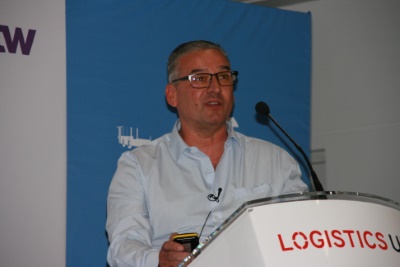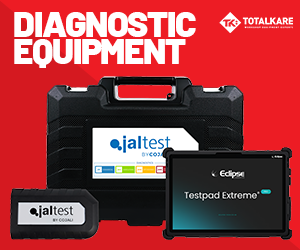Conference warnings delivered on vehicle safety complacency

Many of the vehicle defects identified by DVSA enforcement teams should have been spotted earlier in driver walkaround checks, the agency’s Caroline Hicks warned. Image: Webfleet
Speakers warned delegates at the first of this year’s Logistics UK Transport Manager conferences – which took place at Haynes Motor Museum in Sparkford, Somerset in September – that some transport operators were complacent over the mechanical condition of their vehicles.
Caroline Hicks, the head of regulatory services and transformation at DVSA, said statistics from roadside checks showed that once a vehicle was a month past its MOT test, the risk of a defect serious enough to attract an immediate prohibition being present started to rise.
“This indicates that many vehicles are maintained once a year, prior to their annual test, and people just hope that they won’t get stopped for the rest of the year,” she said.
Random roadside checks of trucks and trailers revealed that 14 per cent were non-compliant, compared to 10 per cent when presented for their annual test. When poorly-performing operators were targeted at roadside checks, 27 per cent of vehicles were found to be faulty.
“The standard required to pass the annual test is published and yet one in 10 vehicles still fail this scheduled check,” she observed.
“The MOT is just the minimum standard of roadworthiness: one in six of HGVs on the road are non-compliant and would get an immediate prohibition at the roadside if stopped.”
She advised operators to ensure they had the whole picture of the maintenance system required to keep their fleets safe, and to be prepared to tighten periodic maintenance inspection (PMI) intervals if it was apparent that things had gone wrong.
“You should also review maintenance processes if the contracts you work on change,” she suggested, pointing out that, for instance, vehicles on ‘final mile’ deliveries were far more prone to tyre damage than those used for trunking.
“If something does go wrong, ask yourself why did it go wrong. Look for gaps in the system, and don’t just focus on the vehicle. A lot of the faults we find should have been found by the driver’s daily walkaround check.”
Ms Hicks went on to explain how technology was transforming roadside enforcement, as some operators might find out to their cost.
Innovations included remote tachograph readers, portable brake testers and a complete mobile test unit.
There was also a camera-equipped robot that was capable of carrying out under-vehicle checks without the need for an inspection pit.
“Don’t think you can navigate around our well-known fixed vehicle examination sites to avoid enforcement any more,” she cautioned.
The national network of ANPR cameras was now recording 80 million vehicles a day and storing the data for a year. This enabled the construction of a ‘heat map’ for suspect vehicles which could accurately predict where they were likely to be and at what times each day.
“If there’s a target vehicle we wish to stop, we can predict where it will be and pick it up with an average wait of only 15 minutes,” she said. “It appears that there are a lot of vehicles being operated when out of test, and we can now detect these by ANPR,” she warned.
The cameras were not used to prosecute speeding offences, but could be used to ensure that vehicles which travelled faster than they should be able to were pulled over for speed limiter checks.
Ms Hicks gave an example of a vehicle belonging to a Cornish operator that she had seen apparently travelling at over 70 mph on the M5. Subsequent camera checks revealed that it had been seen “speeding at multiple locations in the last couple of days.”
She later clarified that DVSA cannot prosecute drivers for speeding, but will check speed limiters and launch prosecutions if they have been tampered with.
“Geofencing can also be used to see if a vehicle travels further than could be legally possible in four-and-a-half hours,” she said.
“We don’t encounter vehicles being double-manned these days, except in the sense that more than one driver’s tacho card may be being used in the same vehicle,” she quipped.
Also speaking at the event was Eric Higham, the senior contract manager of Logistics UK’s vehicle inspection service.
He told operators that there were two key points at which they could ensure that they did not use defective vehicles on the road: the driver’s daily check and the periodic maintenance inspection.
“Both need to be treated as quality monitoring systems,” he advised.
He reminded the transport managers that part of their role was to operate only “fit and serviceable” vehicles, as per the Department for Transport’s Guide to Maintaining Roadworthiness.
Drivers’ walkaround checks should be continuously monitored, ideally by re-examining vehicles as they left or arrived at the yard.
“Get a competent third party to check vehicles after they have undergone PMI, too,” he advised, saying that the Logistics UK vehicle inspection service was well-equipped to do this as it carried out 19,000 roadworthiness and 5,200 gate checks a year.
On gate checks, the top five defects missed by drivers were: 5) damaged mirrors; 4) inoperative windscreen washers or low washer fluid levels; 3) defective tyres, particularly on delivery vans; 2) illuminated dashboard warning lamps; and 1) defective lights: particularly smaller lights such as those that illuminated number plates.
He noted that post PMI checks revealed a notable rise in tyre defects since 2020, with neglect when vehicles were parked up and then put back into service after lockdown being a possible cause.
Some maintenance providers were picking up on defective tyres, but then giving wrong advice. For example, a tyre that was cut to the cords of the carcase should not be ‘monitored’ but replaced immediately.
Maintaining compliance was a cost, but ignoring it was even more expensive. Apart from the legal and safety aspects, the average direct cost of an on-the-road breakdown was £545.
Questions were raised by the audience concerning the performance of commercial workshops. Caroline Hicks said DVSA had no enforcement powers over workshops, unless they were fraudulent.
Senior traffic commissioner (STC) Kevin Rooney, present at the conference as keynote speaker, answered questions in his role as a member of the Maintenance Provision Rating Scheme committee which produced the MPRS rating system for heavy vehicle workshops, introduced earlier this year. He explained why MPRS initially only looked at the training and qualifications of technicians and the equipment available to them rather than results.
“We launched it without Key Performance Indicators. KPIs are really difficult to decide, and far too easy to manipulate, but we will be looking at them next year,” he said.
In the meantime, he warned operators to be alarmed if they were suddenly faced with large bills for preparing a vehicle for MOT test. “Your maintenance provider should be spreading the cost through the year by keeping the truck roadworthy at all times,” he warned.
STC Rooney concluded his keynote speech with a few words about the MPRS, whose development had taken two years. “There aren’t that many workshops in the scheme at the moment,” he admitted, but he urged transport managers to ask their maintenance providers about it.
“We have been contacting operators who have an OCRS [operator compliance risk score] red rating to draw their attention to MPRS in the hope of improving the condition of their fleet. Worryingly, some didn’t know they were red-rated!”
Logistics UK’s Transport Manager conferences continue at various locations across the UK until December.














